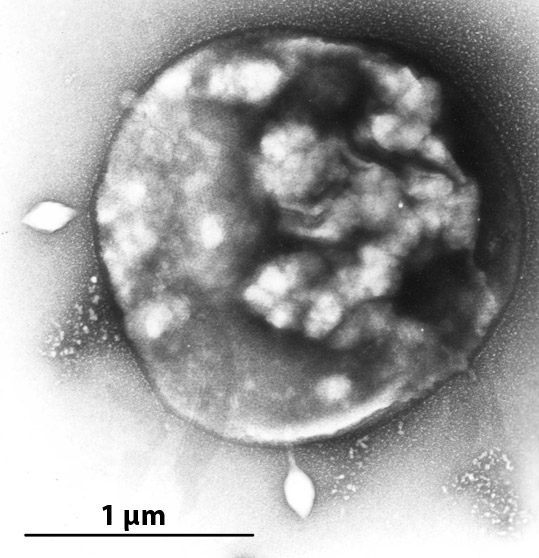|
Bicaudaviridae
''Bicaudaviridae'' is a family of hyperthermophilic archaeal viruses. Members of the genus ''Acidianus'' serve as natural hosts. There is only one genus, ''Bicaudavirus'', and one species, Acidianus two-tailed virus (''Bicaudavirus pozzuoliense''), in this family. However, Sulfolobus tengchongensis spindle-shaped viruses 1 and 2 ( STSV1 and STSV2) are regarded to belong to this family also. Structure Viruses in ''Bicaudaviridae'' are non-enveloped, with lemon-shaped geometries. Genomes are circular dsDNA molecules of around 48–76 kb in length. High-resolution structure was determined by cryo-EM for Sulfolobus monocaudavirus 1 (SMV1) and a lower-resolution structure was determined for Acidianus two-tailed virus (ATV). Virions of both viruses have helical symmetry, with continuous 7-start helices, composed of the single major capsid protein, forming both the tails and the spindle-shaped body. The major capsid protein structure and virion organization of bicaudaviruses are simil ... [...More Info...] [...Related Items...] OR: [Wikipedia] [Google] [Baidu] |
Sulfolobus Tengchongensis Spindle-shaped Virus
Sulfolobus tengchongensis spindle-shaped virus 1 (STSV1) is a DNA virus of the family ''Bicaudaviridae''. It infects the hyperthermophilic archaeon '' Sulfolobus tengchongensis'' which can be found in the volcanic area of Tengchong, Baoshan City, in western Yunnan province, People's Republic of China. In 2014, Sulfolobus tengchongensis spindle-shaped virus 2 (STSV2), a relative of STSV1, also infecting ''S. tengchongensis'', has been reported. Besides ''S. tengchongensis'', STSV2 infects ''Sulfolobus islandicus'' REY15A. It has been demonstrated that STSV2 induces unprecedented gigantism of ''S. islandicus'' cells by blocking the expression of the cell division genes and arresting the cell cycle in the S phase. The diameter of infected cells increases up to 20 times, resulting in 8,000-fold increase in volume compared to noninfected cells. References External links * UCSC Sulfolobus virus STSV1 Genome Browser GatewaySTSV-1, also STSV-2, and Sulfolobus spindle-shaped virus 1, ... [...More Info...] [...Related Items...] OR: [Wikipedia] [Google] [Baidu] |
Archaeal Viruses
An archaeal virus is a virus that infects and replicates in archaea, a domain of unicellular, prokaryotic organisms. Archaeal viruses, like their hosts, are found worldwide, including in extreme environments inhospitable to most life such as acidic hot springs, highly saline bodies of water, and at the bottom of the ocean. They have been also found in the human body. The first known archaeal virus was described in 1974 and since then, a large diversity of archaeal viruses have been discovered, many possessing unique characteristics not found in other viruses. Little is known about their biological processes, such as how they replicate, but they are believed to have many independent origins, some of which likely predate the last archaeal common ancestor (LACA). Much of the diversity observed in archaeal viruses is their morphology. Their complete bodies, called virions, come in many different forms, including being shaped like spindles or lemons, rods, bottles, droplets, and coil ... [...More Info...] [...Related Items...] OR: [Wikipedia] [Google] [Baidu] |
David Prangishvili
David Prangishvili (born 1948) is a virologist, Professor at the Pasteur Institute of Paris, and foremost authority on viruses infecting Archaea. Biography David Prangishvili gained a Master of Science degree in 1971 at Tbilisi State University, Georgia, and a PhD (1977) and Habilitation (1989) from Institute of Molecular Biology of the USSR Academy of Sciences, Moscow. He pioneered research on Archaea, the third domain of life, in the USSR and in 1986-1991 was a head of the department of Molecular Biology of Archaea at the Georgian Academy of Sciences, Tbilisi. In 1991-2004 he has worked in Germany, at Max-Planck Institute for Biochemistry and at Regensburg University. Since 2004 he is working at the Pasteur Institute of Paris. David Prangishvili received a prize of Council of Ministers of the USSR for Excellence in Science and Technology in 1979. David Prangishvili has been elected Member of the Academia Europaea The Academia Europaea is a pan-European Academy of human ... [...More Info...] [...Related Items...] OR: [Wikipedia] [Google] [Baidu] |
Acidianus
''Acidianus'' is a genus of archaeans in the family Sulfolobaceae. Phylogeny The currently accepted taxonomy is based on the List of Prokaryotic names with Standing in Nomenclature (LPSN) and National Center for Biotechnology Information (NCBI) See also * List of Archaea genera This article lists the genera of the Archaea. The currently accepted taxonomy is based on the List of Prokaryotic names with Standing in Nomenclature (LPSN) and National Center for Biotechnology Information (NCBI). However, in the List provided bel ... * List of bacterial genera named after mythological figures References Further reading Scientific journals * * * * Scientific books * External links''Acidianus'' at Bac''Dive'' - the Bacterial Diversity Metadatabase Archaea genera Thermoproteota {{archaea-stub ... [...More Info...] [...Related Items...] OR: [Wikipedia] [Google] [Baidu] |
Latin
Latin ( or ) is a classical language belonging to the Italic languages, Italic branch of the Indo-European languages. Latin was originally spoken by the Latins (Italic tribe), Latins in Latium (now known as Lazio), the lower Tiber area around Rome, Italy. Through the expansion of the Roman Republic, it became the dominant language in the Italian Peninsula and subsequently throughout the Roman Empire. It has greatly influenced many languages, Latin influence in English, including English, having contributed List of Latin words with English derivatives, many words to the English lexicon, particularly after the Christianity in Anglo-Saxon England, Christianization of the Anglo-Saxons and the Norman Conquest. Latin Root (linguistics), roots appear frequently in the technical vocabulary used by fields such as theology, List of Latin and Greek words commonly used in systematic names, the sciences, List of medical roots, suffixes and prefixes, medicine, and List of Latin legal terms ... [...More Info...] [...Related Items...] OR: [Wikipedia] [Google] [Baidu] |



